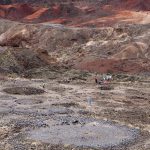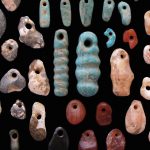When most people think of an archaeological monument, the Great Pyramid of Giza, Stonehenge, and Machu Picchu are usually the most popular to come to mind. However, a new name should be added to the list. In Kenya’s Lake Turkana, archaeologists have recently been examining several pillar sites, including the Lothagam North Pillar Site. At the Lothagam site, the archaeological team have learned that the platform and pit below the pillared site had been built by a community for the use of a communal grave site. In excavating the grave site, the team found an estimated 580 people, spanning across multiple ages and generations. The site has awed the field of archaeology for it seems that community that built the monument constructed it as a means of uniting the people and an example of an egalitarian society, whereas in the past, it has been suggested that the construction of monuments was a way by upper class rulers to emphasize the hierarchy. (Daley) Yet, perhaps more importantly, it raises the question about the relevance of ethics in archaeology, specifically with the uncovering of human remains.
- Figure 1. The site at Lake Turkana where archaeologists are excavating the 5,000 year old monument. Photo Provided by Katherine Grillo.
- Figure 2. Artifacts found from the communal gravesite at Lothagam. While the ornaments were personalized, none of them seemed to distinguish superiority over one another. Photo Provided by Carla Klehm.
This ethical predicament stems from whether it is acceptable to exhume the dead from their burials when excavating a site and the implications surrounding the cultural context. In the past, archaeologists would commonly disrespect sites of human remains when searching for artifacts, and along the way, collected the skeletons and put them in museums. Because they were no sources of power actively trying to protect their history, many of these skeletons were taken from Native American burials during plundering, and the removal of a body from their places of burial ignorantly disregards the importance of the final resting place in many Native American communities. (Alex) Now, more archaeologists are aware of the gravity of their actions, but the issue still arises for many teams whether it is ok to disturb if it is for the benefit of an scientific discovery. The American Anthropological Association has sought to mediate this problem by emphasizing “People and groups have a generic right to realize their capacity for culture, and to produce, reproduce and change the conditions and forms of their physical, personal and social existence, so long as such activities do not diminish the same capacities of others.” This response to the ethical dilemma puts clear stress on how while they do encourage the research into learning cultural past, they condemn it begins to affects the values and wishes of other cultures.
In some ways, we have taken this declaration to heart. The establishment of the Native American Graves Protection and Repatriation Act in 1990 requires the permission of the local community in order for scientists to excavated remains on federal or tribal land. This is a big step in the right direction for achieving the respect Native Americans have been demanding regarding the treatment of their burials, but unfortunately, the law is not regularly enforced and many remains are still taken to museums or reburied.
So, how do we begin to further approach an ethical and safe solution for archaeologists? First, by adhering to the demands of Native American groups and other misrepresented cultures around the world when addressing their burial grounds. This also includes respecting their wishes in all research, including online, by not posting images of human bones in case it does belong to one of their people. (Class) Next, we encourage scientific development in excavation tools that will allow archaeologists to investigates, but disturb as little as possible.
In the Lothagam site, archaeologists have already found through the study of some the remains that the drying of Lake Turkana forced diverse groups of people to unite and work together. (Alex) This is important for outlining more of the area’s history, but again, it can only truly be successful should it be done responsibly and ethically. Thankfully, that is the case.
Further Readings:
Killgrove, Kristina.
2018 International Experts Refute ‘Alien’ Mummy Analysis, Question Ethics and Legality. Forbes, July 18, 2018. https://www.forbes.com/sites/kristinakillgrove/2018/07/18/international-experts-refute-alien-mummy-analysis-question-ethics-and-legality/#32327dc93722
Strauss, Mark.
2016 When Is It Okay To Dig Up The Dead? National Geographic, April 7, 2016. https://news.nationalgeographic.com/2016/04/160407-archaeology-religion-repatriation-bones-skeletons/
Reference List:
Daley, Jason.
2018 Their World Was Crumbling But These Ancient People Built a Lasting Memorial
Read. Smithsonian Magazine, August 22, 2018. https://www.smithsonianmag.com/science-nature/when-their-world-was-chaos-these-ancient-people-coped-building-monument-180970087/, accessed November 4, 2018.
Alex, Bridget
2018 When Is It Ok For Archaeologists To Dig Up the Dead? Discover Magazine Blog, September 7, 2018. http://blogs.discovermagazine.com/crux/2018/09/07/when-is-it-ok-for-archaeologists-to-dig-up-the-dead/#.W9-pXS2ZP-Y, accessed November 4, 2018.
Image Sources:
Daley, Jason.
2018 Their World Was Crumbling But These Ancient People Built a Lasting Memorial
Read. Smithsonian Magazine, August 22, 2018. https://www.smithsonianmag.com/science-nature/when-their-world-was-chaos-these-ancient-people-coped-building-monument-180970087/, accessed November 4, 2018.



Great post! NAGPRA and other measures to ensure the protection of Native/Indigenous sites are really important and pieces of policy I keep close to my little heart. I was interested in your discussion of the role of anthropologists and archaeologists in disturbing Native remains. Recently, there have been more archaeologists who are doing what they call “Indigenous archaeology,” where they do work with and for Native groups. For example, there was an archaeologists who attempted to help one of the five Iroquois tribes (Cayuga, I think) get recognition on their request using archaeology as evidence. What do you think the role of the archaeologist in the future, ethically, should be?